
Paris, the name alone conjures images of romance, art, history, and unparalleled culinary delights. It’s a city that lives up to its reputation, a place where every cobblestone street whispers stories and every corner reveals a new masterpiece. Whether you’re a first-time visitor or a seasoned traveler, Paris offers an endless tapestry of experiences waiting to be discovered. This comprehensive guide will equip you with the knowledge you need to navigate the city of lights and create unforgettable memories.
Top Attractions: A Journey Through Iconic Landmarks
Paris is a treasure trove of iconic landmarks, each with its own unique story to tell. No trip to Paris is complete without visiting these must-see attractions:

Related Articles about Paris: A Timeless Guide to the City of Lights:
- Canada: A Traveler’s Grand Tapestry – From Majestic Peaks to Coastal Charms
- Osaka: A Culinary Capital and Cultural Crossroads
- Krabi: Thailand’s Andaman Jewel – A Comprehensive Travel Guide
- A Wanderer’s Guide to Sweden: Unveiling the Land of Fjords, Forests, and Fika
- Cairo: A Timeless Tapestry of Ancient Wonders and Modern Marvels
-
The Eiffel Tower: The undisputed symbol of Paris, the Eiffel Tower is a feat of engineering and a testament to human ingenuity. Ascend to the top for breathtaking panoramic views of the city. Consider booking tickets online in advance to avoid long queues, especially during peak season.
-
The Louvre Museum: Home to some of the world’s most celebrated artworks, including the Mona Lisa and the Venus de Milo, the Louvre Museum is a cultural behemoth. Allocate at least half a day, if not a full day, to explore its vast collections. Prioritize the exhibits you’re most interested in and consider joining a guided tour to maximize your time.
-
Notre-Dame Cathedral: A masterpiece of Gothic architecture, Notre-Dame Cathedral is a testament to faith and artistry. While still undergoing restoration after the devastating fire of 2019, the exterior remains a captivating sight. The area around the cathedral offers stunning views and a sense of history.

-
Arc de Triomphe: Standing proudly at the end of the Champs-Élysées, the Arc de Triomphe commemorates those who fought for France, particularly during the Napoleonic Wars. Climb to the top for another spectacular view of the city, this time with a unique perspective down the iconic avenue.
-
Champs-Élysées: Stroll down the most famous avenue in the world, lined with luxury boutiques, theaters, and cafes. It’s a vibrant and bustling thoroughfare, perfect for people-watching and soaking up the Parisian atmosphere.
-
Montmartre: Perched atop a hill, Montmartre is a charming neighborhood known for its artistic heritage and the Sacré-Cœur Basilica. Explore the Place du Tertre, where artists create and sell their work, and enjoy the stunning views from the basilica’s dome.
-
The Palace of Versailles: Located just outside Paris, the Palace of Versailles is a symbol of royal opulence and a testament to the grandeur of the French monarchy. Explore the palace’s lavish interiors, wander through its expansive gardens, and immerse yourself in the history of the French court.
-
Sainte-Chapelle: Tucked away on the Île de la Cité, Sainte-Chapelle is a hidden gem renowned for its breathtaking stained-glass windows. The vibrant colors and intricate designs create a truly mesmerizing experience.
-
Musée d’Orsay: Housed in a former railway station, the Musée d’Orsay showcases Impressionist and Post-Impressionist masterpieces by artists such as Monet, Renoir, Degas, and Van Gogh.
-
The Latin Quarter: Home to the Sorbonne University, the Latin Quarter is a vibrant student district filled with bookstores, cafes, and historical landmarks. Explore the Panthéon, a neoclassical monument dedicated to prominent French figures, and stroll through the Jardin du Luxembourg, a beautiful park perfect for relaxation.
A Glimpse into History: Tracing Paris’s Rich Past
Paris boasts a rich and complex history, spanning millennia and leaving an indelible mark on the city’s architecture, culture, and identity.
-
Roman Origins: Founded by the Parisii tribe, the city was conquered by the Romans in the 1st century BC and renamed Lutetia. Remnants of Roman Paris can still be seen today, including the Arènes de Lutèce, an ancient amphitheater.
-
Medieval Paris: During the Middle Ages, Paris emerged as a major center of trade, learning, and religion. The construction of Notre-Dame Cathedral began in the 12th century, marking a significant period in the city’s architectural development.
-
The Renaissance and the Enlightenment: The Renaissance brought a renewed interest in art and culture, transforming Paris into a hub of creativity. The Enlightenment saw the rise of intellectual salons and philosophical debates, shaping the city’s intellectual landscape.
-
The French Revolution: The French Revolution of 1789 dramatically altered the course of French history, with Paris at the center of the storm. The storming of the Bastille marked the beginning of the revolution, leading to the overthrow of the monarchy and the establishment of a republic.
-
The Napoleonic Era: Napoleon Bonaparte’s reign brought a period of imperial grandeur to Paris. He commissioned numerous architectural projects, including the Arc de Triomphe, to commemorate his military victories.
-
The Belle Époque: The late 19th and early 20th centuries, known as the Belle Époque, were a time of artistic and cultural flourishing in Paris. The city hosted the World’s Fair in 1889, showcasing technological advancements and artistic innovations.
-
World War II and Beyond: Paris was occupied by Nazi Germany during World War II, a period of hardship and resistance. After the war, the city underwent a period of reconstruction and modernization, solidifying its position as a global center of culture and commerce.
Essential Travel Tips: Navigating Paris Like a Local
To ensure a smooth and enjoyable trip to Paris, consider these essential travel tips:
-
Learn Basic French Phrases: While many Parisians speak English, knowing a few basic French phrases will be greatly appreciated and enhance your interactions with locals. Phrases like "Bonjour," "Merci," "S’il vous plaît," and "Excusez-moi" will go a long way.
-
Utilize Public Transportation: Paris has an extensive and efficient public transportation system, including the Metro, buses, and RER trains. Purchase a travel pass for unlimited rides within a specific zone.
-
Walk Whenever Possible: Paris is a walkable city, and exploring on foot allows you to discover hidden gems and soak up the atmosphere. Wear comfortable shoes and be prepared to walk long distances.
-
Be Aware of Pickpockets: Like any major city, Paris has its share of pickpockets, particularly in crowded tourist areas. Be vigilant with your belongings and keep your valuables secure.
-
Make Reservations in Advance: For popular restaurants and attractions, it’s advisable to make reservations in advance, especially during peak season.
-
Embrace the Café Culture: Parisian cafes are an integral part of the city’s culture. Take time to relax at a café, sip a coffee or glass of wine, and people-watch.
-
Dress Appropriately: Parisians are known for their stylish attire. While there’s no strict dress code, dressing smartly will help you blend in and feel more confident.
-
Tip Appropriately: Tipping is not mandatory in Paris, but it’s customary to leave a small tip (around 5-10%) for good service at restaurants and cafes.
-
Be Prepared for Crowds: Paris is a popular tourist destination, so be prepared for crowds, especially during peak season. Arrive early at popular attractions to avoid long queues.
-
Enjoy the Food! Paris is a culinary paradise, offering a wide range of gastronomic delights. From traditional French cuisine to international flavors, there’s something to satisfy every palate. Don’t miss out on trying classic dishes like croissants, macarons, steak frites, and crème brûlée.
Accommodation Options: Finding Your Perfect Parisian Home
Paris offers a wide range of accommodation options to suit every budget and preference:
-
Luxury Hotels: For a truly indulgent experience, consider staying at one of Paris’s many luxury hotels, offering impeccable service, elegant decor, and prime locations. Examples include The Ritz Paris, Four Seasons Hotel George V, and Le Bristol Paris.
-
Boutique Hotels: Boutique hotels offer a more intimate and stylish experience, with unique designs and personalized service. Examples include Hotel Saint-André des Arts, Hotel Fabric, and Hotel Providence.
-
Mid-Range Hotels: Mid-range hotels provide comfortable and well-equipped accommodations at a reasonable price. Examples include Hotel Jardin Le Brea, Hotel Saint Paul Rive Gauche, and Hotel Eiffel Trocadéro.
-
Budget Hotels and Hostels: For budget-conscious travelers, there are numerous budget hotels and hostels offering affordable accommodation. Examples include Generator Paris, St Christopher’s Inn Canal, and Hotel Cluny Square.
-
Apartments: Renting an apartment can be a great option for longer stays, offering more space and flexibility. Airbnb and VRBO offer a wide selection of apartments in various neighborhoods throughout Paris.
Transportation: Getting Around the City of Lights
Paris boasts an efficient and well-connected transportation system:
-
Metro: The Paris Metro is the most convenient way to get around the city, with an extensive network of lines covering most areas.
-
Buses: Buses are another option for getting around, offering scenic routes and access to areas not served by the Metro.
-
RER Trains: The RER trains connect Paris to the suburbs and nearby attractions, such as the Palace of Versailles.
-
Taxis and Ride-Sharing Services: Taxis and ride-sharing services like Uber are readily available, but can be more expensive than public transportation.
-
Vélib’ Bikes: Vélib’ is a bike-sharing program that allows you to rent bikes and explore the city at your own pace.
-
Walking: As mentioned earlier, walking is a great way to experience Paris, especially in the central neighborhoods.
Best Time to Visit: Planning Your Parisian Getaway
The best time to visit Paris depends on your preferences and priorities:
-
Spring (April-May): Spring is a beautiful time to visit Paris, with pleasant weather, blooming flowers, and fewer crowds than summer.
-
Summer (June-August): Summer is the peak tourist season, with warm weather and long days. Be prepared for crowds and higher prices.
-
Autumn (September-October): Autumn is another excellent time to visit, with mild weather, vibrant fall foliage, and fewer tourists.
-
Winter (November-March): Winter can be cold and rainy, but it also offers a unique charm, with festive Christmas markets and cozy cafes.
Paris is a city that captivates the senses and leaves an indelible mark on the soul. By following this guide, you’ll be well-equipped to navigate the city of lights, explore its iconic landmarks, immerse yourself in its rich history, and create memories that will last a lifetime. Bon voyage!





